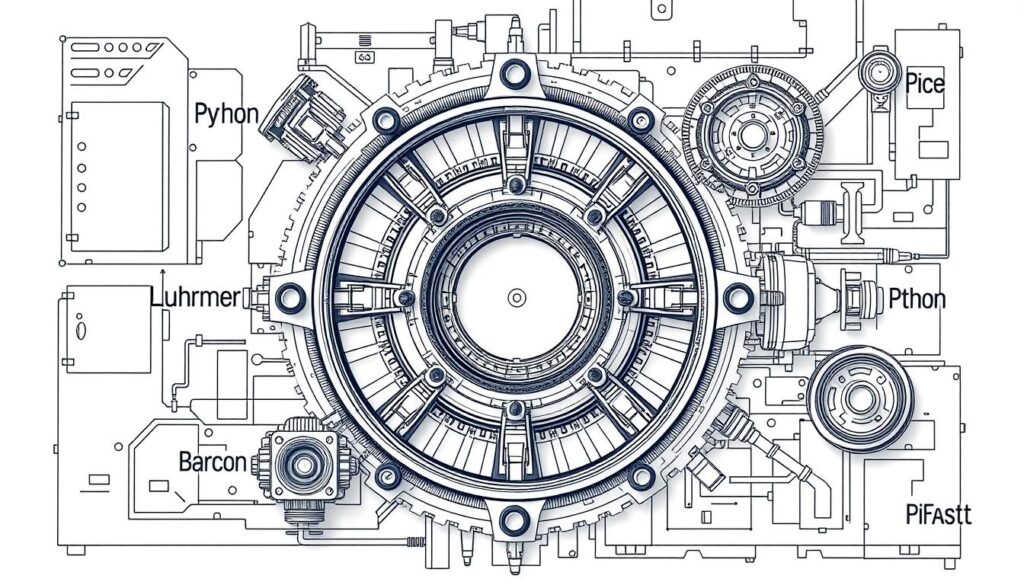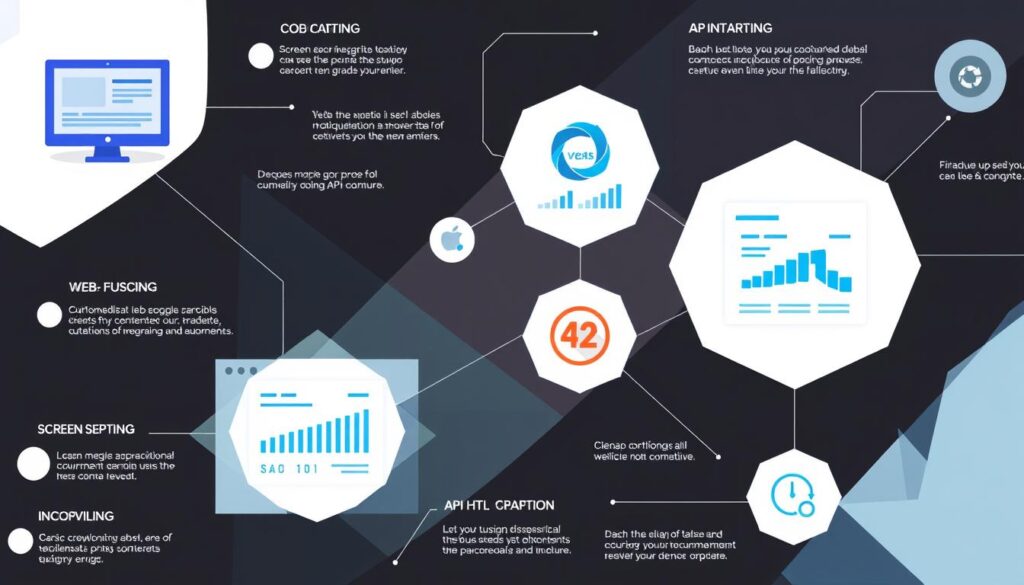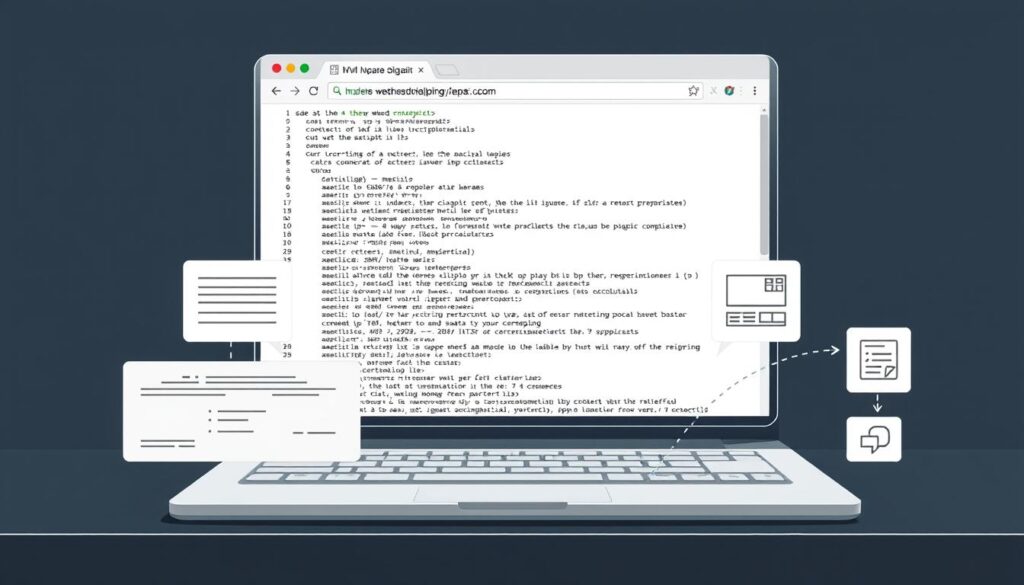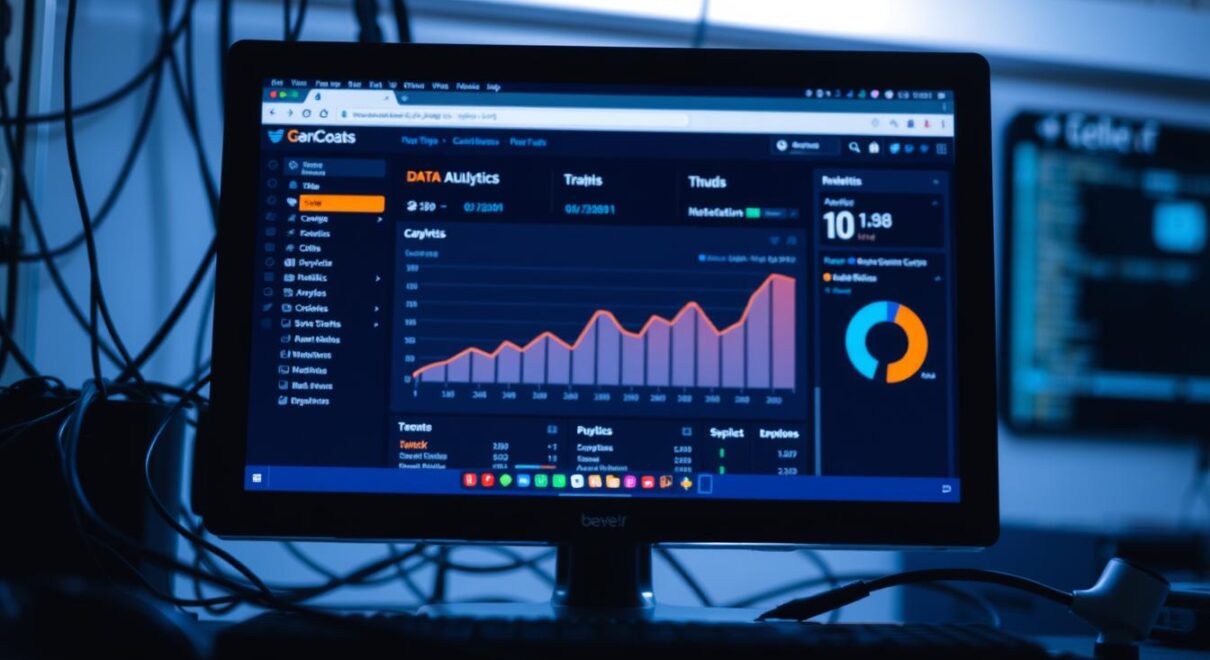Web scraping is a crucial tool in our data-driven world. It automatically extracts information from websites. This guide will teach you the basics of website data scraping.
Data extraction can revolutionize businesses and individuals. It quickly gathers large amounts of information for various purposes. Web scraping can boost data collection efficiency by 50-70% compared to manual methods.
Small businesses are discovering web scraping’s benefits. About 20-30% use it for market analysis and competitor tracking. Over 70% of organizations using web scraping recognize its market value.
This guide covers essential tools and basic steps for effective web scraping. You’ll also learn advanced techniques to refine your skills. This overview will help you master website data extraction.
Key Takeaways
- Web scraping automates data collection, increasing efficiency by 50-70%
- 20-30% of small businesses use web scraping for market analysis
- Over 70% of organizations find web scraping valuable for staying competitive
- Web scraping can handle up to 300 requests per second with tools like Zenrows
- 90% of web pages use HTML structures, making HTML parsing crucial
- Ethical web scraping practices are essential for legal compliance
Understanding Web Scraping Fundamentals
Web scraping is a powerful data extraction technique. It’s crucial for web crawler development and data mining. This process automates collecting information from websites efficiently.
What is Web Scraping?
Web scraping uses programs to gather data from websites automatically. It’s like having a digital assistant that reads and saves web content. This process often includes HTML parsing and REST API data mining.
Python is the top choice for web scraping among data analysts. Its user-friendly syntax and extensive libraries make it popular. Beautiful Soup and Scrapy are widely used in scraping projects.
Common Use Cases for Web Scraping
Companies use web scraping for various purposes. Market research firms often gather data from social media and online forums. It’s also used for price monitoring, lead generation, and content aggregation.
| Use Case | Percentage |
|---|---|
| Market Research | 60% |
| Contact Scraping | 50% |
| Price Monitoring | 40% |
Legal and Ethical Considerations
Ethical practices are crucial when scraping data from websites. Many web scraping efforts face legal compliance issues. Always respect website terms of service and robots.txt files.
Most web scraping tasks require following guidelines in the target website’s robots.txt file. By adhering to these rules, you can keep your activities ethical and legal.
Essential Tools and Libraries for Web Scraping
Web scraping is crucial for data-driven businesses. It’s used by 60% of companies for competitive analysis. Let’s explore tools that make data extraction efficient and effective.
Python-based Scraping Libraries
Python is the top choice for web scraping. 90% of developers prefer it for this task. Here are some popular Python libraries for web scraping:
- BeautifulSoup: Ideal for parsing HTML and XML. It’s used by Intuit and Airbnb for small projects.
- Requests: Used by Reddit and Spotify for basic data pulling tasks.
- Scrapy: Perfect for large-scale scraping. Companies like Lyst use it to manage big datasets.
- Lxml: Efficiently handles complex HTML documents.

JavaScript Scraping Tools
JavaScript tools are key for scraping dynamic websites. 40% of web scraping projects use headless browser tools. Selenium is a favorite of Google and Shopify.
It supports all major browsers and excels at browser automation. This makes it a powerful choice for complex scraping tasks.
Browser Developer Tools
Browser developer tools are vital for HTML parsing and web crawler development. They help inspect page structures and identify CSS selectors. These tools are crucial for understanding dynamic content loading.
These skills are essential for building efficient scrapers. They’re especially important when dealing with complex web applications.
The right mix of tools can tackle various scraping tasks. This includes simple static pages and complex JavaScript-rendered sites. Advanced scrapers now use machine learning for better data extraction.
Setting Up Your Web Scraping Environment
Python web scraping needs a proper setup. Let’s explore the key steps to create your scraping environment. This guide will help you get started quickly.
First, install Python 3.12.0 or later. This version works best for web scraping. Then, set up a virtual environment for your project dependencies.
Use pip to install these essential web scraping tools:
- requests: Simplifies HTTP requests
- BeautifulSoup: Parses HTML and XML documents
- Selenium: Automates browser interactions
These libraries are vital for most python web scraping projects. They save developers a lot of time and effort.
Set up your browser’s Developer Tools too. Use F12 on Windows or Option + ⌘ + I on macOS. These tools help inspect webpage elements.
- Respect robots.txt files
- Use identifiable user-agent strings
- Implement request throttling (1 request per 2-5 seconds)
Now you’re ready to explore web scraping. Test your code carefully to avoid data corruption issues. Happy scraping!
| Web Scraping Tool | Primary Use | Key Benefit |
|---|---|---|
| Requests | Making HTTP requests | Simplifies code, reducing lines needed |
| BeautifulSoup | Parsing HTML/XML | Automates encoding detection |
| Selenium | Browser automation | Handles dynamic JavaScript content |
How to Scrape Website Data: Basic Steps and Methods
Web scraping is vital for extracting data from websites. It involves key steps and techniques for efficient data collection.
Making HTTP Requests
To start web scraping, make HTTP requests to fetch web page content. Python’s requests library helps retrieve data easily.
import requests
url = 'http://example.com'
response = requests.get(url)
html_content = response.text
Parsing HTML Content
After getting HTML content, parse it using BeautifulSoup. This popular library makes HTML parsing simple and effective.
from bs4 import BeautifulSoup
soup = BeautifulSoup(html_content, 'html.parser')
Extracting Specific Data Elements
Once parsed, extract specific data elements using various techniques. Here’s an example of how to extract a title:
title = soup.find('title').text
print(title)
| Web Scraping Use Case | Percentage |
|---|---|
| Price intelligence in businesses | 60% |
| Financial analysts using scraped data | 70% |
| Content aggregators relying on web scraping | 80% |
| Companies reporting improved decision-making | 80% |
These stats show how important web scraping is across industries. Mastering these steps can help you harness data scraping’s power.
With these skills, you’ll be able to collect valuable information for various projects and needs.

Understanding HTML Structure and DOM Navigation
HTML parsing is vital for web crawler development. It’s crucial to grasp HTML structure and DOM navigation for effective data extraction. Let’s explore the key elements of web pages and how to traverse them.
HTML documents are made up of nested elements. Common tags include <div> for divisions, <a> for links, and <p> for paragraphs. These elements form a tree structure called the DOM.
Web scrapers navigate the DOM to find and extract information. Understanding block and inline elements is important when developing a web crawler. Block elements start on a new line and use full width.
Inline elements flow within text and only use necessary width. Block elements include <div> and <p>, while inline elements include <span> and <a>.
| Element Type | Examples | Behavior |
|---|---|---|
| Block | <div>, <p>, <h1> | Start on new line, full width |
| Inline | <span>, <a>, <strong> | Flow within text, width as needed |
Efficient DOM traversal is essential for robust web scraping. Using attributes like id and class helps scrapers find specific elements quickly. This method improves the accuracy and speed of data extraction in web crawler projects.
Working with BeautifulSoup and Requests Libraries
Python coders love BeautifulSoup and Requests for web scraping. These tools make it easy to extract data from websites. They also help follow best practices for web scraping.
Installing Required Dependencies
To start web scraping, you need to install some libraries. Open your command prompt and type:
- pip install requests beautifulsoup4 pandas
This installs Requests for HTTP requests and BeautifulSoup for parsing HTML. It also adds Pandas for data handling.
Basic Scraping Operations
After installation, you can begin scraping websites. Here’s a simple example of how to scrape data:
- Import the libraries
- Make a request to the website
- Parse the HTML content
- Extract specific data elements

BeautifulSoup is great at parsing complex HTML structures. It makes it easier to navigate and extract web data. Here’s how to find a page title:
- title = soup.find(‘title’).text
- print(title)
Error Handling Techniques
When extracting data, it’s important to handle potential errors. Use try-except blocks to manage request failures and keep data safe. Here’s an example:
- try:
response = requests.get(url)
response.raise_for_status()
except requests.exceptions.RequestException as e:
print(f”An error occurred: {e}”)
Following these steps and using error handling will improve your scraping skills. You’ll build better scrapers and practice ethical web scraping.
Advanced Scraping Techniques with Selenium
Selenium is a powerful tool for web crawler development. It excels in JavaScript rendering, making it perfect for scraping dynamic websites. Selenium handles content that relies heavily on JavaScript for display.
Handling Dynamic Content
Selenium effectively manages dynamic content that loads asynchronously. It interacts with AJAX-powered features and single-page applications. This ensures thorough data extraction from modern websites.
Browser Automation
Selenium excels in browser automation, a key aspect of advanced web scraping. It navigates web pages, interacts with forms, and handles pop-ups. This ability is crucial for scraping sites requiring user authentication or complex interactions.

JavaScript Rendered Pages
Selenium’s JavaScript rendering capabilities are unmatched. It can execute JavaScript on web pages, accessing dynamically loaded content. This makes it invaluable for scraping dynamic websites where traditional methods fail.
About 60% of modern websites need dynamic content handling due to JavaScript usage. Selenium effectively addresses this need in web crawler development.
Selenium combined with BeautifulSoup can handle pages that require JavaScript execution, improving data accessibility in web scraping projects.
Developers can create robust web scraping solutions using Selenium’s capabilities. These solutions navigate complex web applications effectively. This ensures comprehensive and accurate data extraction from modern websites.
Data Extraction and Storage Methods
Web scraping transforms data collection. Companies gather insights from online sources using data extraction. This process involves pulling and storing information for analysis.
Extracting data needs careful planning. Identify the specific elements you want to collect. Use tools like Python libraries to automate the extraction process.
Data cleaning and normalization are crucial after extraction. Raw data often has errors or inconsistencies. Cleaning removes duplicates and fixes formatting issues.
Normalization ensures data is ready for analysis. Efficient storage of scraped data is important. You can use formats like CSV, JSON, or XML.
Here’s a simple example of storing data in a CSV file using Python’s pandas library:
import pandas as pd
data = {'Title': titles, 'Content': contents}
df = pd.DataFrame(data)
df.to_csv('output.csv', index=False)
For larger datasets, databases are better. They offer improved organization and faster retrieval. MySQL works for structured data, while MongoDB suits unstructured data.
Ethical scraping is crucial. Always check a website’s robots.txt file before scraping. This helps avoid legal issues and maintains good web citizenship.
Handling Different Types of Web Content
Web scraping extracts data from various web content types. Let’s explore three key approaches for handling different web structures.
Static HTML Pages
Static HTML pages are easiest to scrape. Their content is directly embedded in the HTML source. HTML parsing tools like BeautifulSoup excel at extracting data from static websites.
You can easily scrape text, images, and links using simple requests and parsing techniques.

Dynamic JavaScript Content
Scraping dynamic websites presents unique challenges. These pages often use JavaScript to render content after initial loading. Tools like Selenium or Playwright can handle javascript rendering for dynamic content extraction.
These tools interact with dynamic elements and handle lazy-loading content. They can extract data from complex web applications effectively.
API Integration
Many websites offer APIs for efficient data access. REST API data mining can be a powerful alternative to traditional scraping. Web scraping APIs often provide structured data with fewer restrictions.
They require proper authentication for integration into your scraping workflow. This allows for comprehensive data collection from various sources.
| Content Type | Scraping Method | Tools |
|---|---|---|
| Static HTML | HTML parsing | BeautifulSoup, Requests |
| Dynamic JavaScript | Browser automation | Selenium, Playwright |
| API | API requests | Requests, API libraries |
Understanding these content types and scraping techniques is crucial. It enables effective data extraction from various websites and web applications.
Managing Rate Limiting and IP Rotation
Web scraping best practices include managing rate limiting and IP rotation. These techniques help maintain ethical web scraping practices. They also prevent detection and server overload.
Proxy Management
Proxy management is crucial for large-scale web scraping projects. It involves rotating through different IP addresses to distribute requests. This reduces the risk of getting blocked.
Premium proxy services often offer better performance and reliability. They’re usually more effective than free options.
You can implement proxy rotation in Python using libraries like `fake-useragent. This allows switching between User-Agent strings. It helps avoid rate limits tied to specific user agents.
- Rotate user agents and residential proxies to mimic human behavior
- Use proxy services that offer a pool of IP addresses
- Monitor proxy performance and switch when necessary
Request Throttling
Request throttling is key to ethical web scraping. It controls the rate of requests to avoid overwhelming target websites.
Here are some effective throttling techniques:
- Implement delays between requests (e.g., 5-second delay using time.sleep())
- Use exponential backoff strategy for high-traffic sites
- Monitor server responses to adjust delay settings
- Employ task queue systems like Celery to manage request rates
Following these practices helps balance efficient data collection and respecting website resources. Always check the target website’s robots.txt file and terms of service.
Error Handling and Debugging Strategies
Error handling and debugging are vital for web scraping success. These practices boost project reliability and efficiency. Implementing robust strategies can make a big difference in your scraping efforts.
Web scraping often faces various challenges. About 70% of scrapers struggle with data extraction issues. Another 60% find discrepancies between scraped and displayed data.
To address these problems, try these approaches:
- Implement exception handling to manage request failures
- Use logging for better visibility into the scraping process
- Employ retry mechanisms with exponential backoff
- Rotate user agents and use proxies to reduce blocking attempts
Good error handling can cut script termination rates by over 50%. Setting HTTP request timeouts to 5 seconds balances speed and reliability. Retry mechanisms can boost success rates by 20-30% on failed requests.
Remember, proper error handling isn’t just about catching exceptions – it’s about gracefully managing unexpected situations to maintain data integrity.
Here’s a table summarizing common errors and their handling strategies:
| Error Type | Occurrence Rate | Handling Strategy |
|---|---|---|
| Network Failures | 25% | Implement retry mechanisms |
| 403 Forbidden | Common | Use appropriate request headers |
| 429 Too Many Requests | Frequent | Implement rate limiting |
| 404 Not Found | Variable | Handle gracefully to prevent crashes |
Using these strategies can greatly improve your web scraping projects. They’ll help make your scraping more robust and efficient. Your data collection will become more reliable and effective.
Best Practices for Efficient Web Scraping
Web scraping best practices are key for successful data extraction. Over 70% of businesses use web scraping to gather information. Efficient techniques can boost success rates by 40% and reduce extraction time by 25%.
Performance Optimization
To improve data extraction, focus on multithreading. Tools like Scrapy Redis allow multiple requests to a single domain. This speeds up data acquisition, especially for large-scale operations.
Handling dynamic content is crucial for efficient web scraping. Many modern web apps use JavaScript and Ajax. Implement specialized techniques for JavaScript rendering to ensure thorough data collection.
Data quality checks after extraction are vital. Studies show that 30% of scraped data can be inaccurate. Implement robust error handling and quality control measures to improve data integrity.





